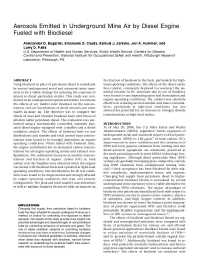Mining Publication: Aerosols Emitted in Underground Mine Air by Diesel Engine Fueled with Biodiesel
Original creation date: February 2010
Using biodiesel in place of petroleum diesel is considered by several underground metal and nonmetal mine operators to be a viable strategy for reducing the exposure of miners to diesel particulate matter. This study was conducted in an underground experimental mine to evaluate the effects of soy methyl ester biodiesel on the concentrations and size distributions of diesel aerosols and nitric oxides in mine air. The objective was to compare the effects of neat and blended biodiesel fuels with those of ultralow sulfur petroleum diesel. The evaluation was performed using a mechanically controlled, naturally aspirated diesel engine equipped with a muffler and a diesel oxidation catalyst. The effects of biodiesel fuels on size distributions and number and total aerosol mass concentrations were found to be strongly dependent on engine operating conditions. When fueled with biodiesel fuels, the engine contributed less to elemental carbon concentrations for all engine operating modes and exhaust configurations. The substantial increases in number concentrations and fraction of organic carbon (OC) in total carbon over the baseline were observed when the engine was fueled with biodiesel fuels and operated at light-load operating conditions. Size distributions for all test conditions were found to be single modal and strongly affected by engine operating conditions, fuel type, and exhaust configuration. The peak and total number concentrations as well as median diameter decreased with an increase in the fraction of biodiesel in the fuels, particularly for highload operating conditions. The effects of the diesel oxidation catalyst, commonly deployed to counteract the potential increase in OC emissions due to use of biodiesel, were found to vary depending upon fuel formulation and engine operating conditions. The catalyst was relatively effective in reducing aerosol number and mass concentrations, particularly at light-load conditions, but also showed the potential for an increase in nitrogen dioxide concentrations at high-load modes. Implications Changing fuel supply from petroleum diesel to biodiesel fuels has been adopted by several underground mines as a method of choice for controlling the exposure to diesel aerosols. The results of this study provide more insight into potential advantages and disadvantages of using biodiesel fuels for controlling emissions of aerosols and gases. The role of diesel oxidation catalysts in controlling biodiesel emissions has also been re-examined. Substantial changes in physical and chemical properties of aerosols, observed when diesel was replaced with biodiesel, warrant further research on establishing the potential health risks associated with exposure to those aerosols.
Authors: AD Bugarski, EG Cauda, SJ Janisko, JA Hummer, LD Patts
Peer Reviewed Journal Article - February 2010
NIOSHTIC2 Number: 20036484
J Air Waste Manage Assoc 2010 Feb; 60(2):237-244
See Also
- Control Technologies and Strategies for Reducing Exposure of Underground Miners to Diesel Emissions
- Diesel Emissions Control Technologies in Coal Mines
- Diesel Emissions Control Technologies in Metal/Nonmetal Mines
- The Effectiveness of Selected Technologies in Controlling Diesel Emissions in an Underground Mine: Isolated Zone Study at Stillwater Mining Company's Nye Mine
- The Effects of Water Emulsified Fuel on Diesel Particulate Matter Concentrations in Underground Mines
- Mutagenicity of Diesel Exhaust Particles from an Engine with Differing Exhaust After Treatments
- Real-Time Estimation of Elemental Carbon Emitted from a Diesel Engine
- Size Distribution and Deposition in Human Respiratory Tract: Particle Mass and Number
- Strategies to Reduce Miners Exposure to DPM and Gases (Reno)
- Technology News 514 - The Air Quantity Estimator (AQE): A New Computer Software Tool for Large-opening Mine Ventilation Planning
- Content source: National Institute for Occupational Safety and Health, Mining Program


 ShareCompartir
ShareCompartir
